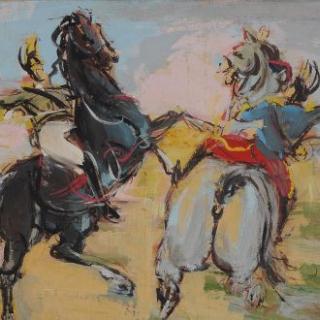
Nowadays, Luis (also known as Lojze or Luigi) Spazzapan is well-known in the art world for his paintings and sculptures. Now known as an Italian painter, he was in fact a member of Italy’s Slovenian community. But despite being proud of his Slovenian origins, he was never fully accepted by Slovenia’s art establishment.
Born in 1889 in the town of Gradisca, now in Italy but inhabited by both Slovenians and Italians, Spazzapan grew up in a modest family; his father was a prison guard. The young Spazzapan served in the Austrian army during World War I and even spent some time on the Russian front. He managed to survive the war and became a math teacher in the town of Idrija. The high school where he taught was the oldest of its kind of Slovenia and had a reputation for academic excellence, but Spazzapan’s true passions lay elsewhere. He soon quit his job to work as a painter and - to a lesser extent - as a sculptor.
He had always loved art and traveled across Europe to attend exhibitions; he was particularly intrigued by the avant-garde movements of the time, including futurism and abstraction. After quitting his teaching career, he developed his own variety of futurism, which quickly began to attract the attention of the art community.
By the late 1920s, Spazzapan had already participated in a number of exhibitions across Italy and his work was often exhibited alongside other leading Italian practitioners of futurism. He finally decided to move to Turin, a large city with more opportunity for an innovative artist. There, he became well known for his portraits, landscapes, and other motifs created in a style that drew from both futurism and cubism. In 1936, he was invited to participate in the prestigious Venice Biennale.
Spazzapan also exhibited in Slovenia, but he was never embraced by the art establishment in the country. At the time, the Slovenian art world was run by conservatives who distrusted Spazzapan’s avant-garde approach. Abroad, however, the artist became widely respected, and in 1954, he had his first solo exhibition in Venice. He died four years later in his adoptive Turin.
Today, Spazzapan is considered a master of mid-century Italian art, one of the most respected representatives of the futurist movement. Despite his lack of acceptance in Slovenia, Spazzapan was always proud of his Slovenian roots, and his works are now also being rediscovered on the Slovenian side of the border. A memorial room dedicated to his creations has recently been opened in Ajdovščina, giving new generations of Slovenians a chance to examine the unique vision of this Slovenian-Italian master.

































































